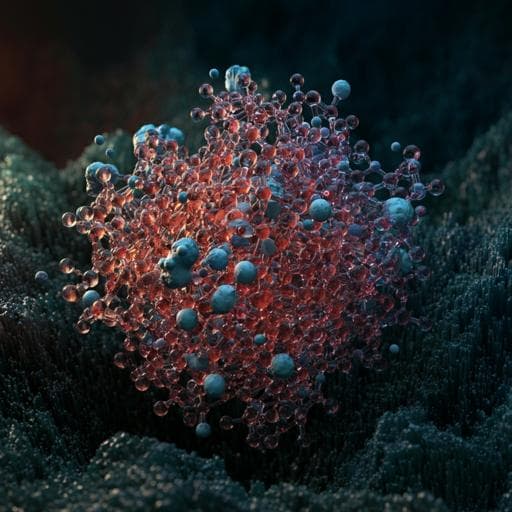
Chemistry
AdsorbML: a leap in efficiency for adsorption energy calculations using generalizable machine learning potentials
J. Lan, A. Palizhati, et al.
Discover AdsorbML, a groundbreaking machine learning algorithm developed by Janice Lan, Aini Palizhati, Muhammed Shuaibi, Brandon M. Wood, and others, which drastically enhances the speed and accuracy of calculating adsorption energies for adsorbate-catalyst interactions. With a remarkable 87.36% success rate and a speed 2000 times faster than traditional methods, this research is set to revolutionize the field.
~3 min • Beginner • English
Introduction
The study addresses the core challenge in heterogeneous catalyst discovery of accurately and efficiently computing adsorption energies for adsorbate–surface systems, a foundational step for constructing free energy diagrams and predicting catalytic activity and selectivity. Calculating adsorption energies requires locating the global minimum across a vast configuration space of binding sites and orientations, followed by local structure relaxations (typically via DFT). Conventional heuristic placement strategies and researcher intuition do not scale to high-throughput screening and can miss the true minima, particularly for flexible adsorbates and complex surfaces. DFT-based searches are computationally expensive (single relaxations can take ~24 hours and brute-force screening at scale is intractable), motivating hybrid approaches that leverage fast, generalizable machine learning (ML) interatomic potentials to accelerate the search while retaining DFT accuracy in verification. The paper proposes AdsorbML, a hybrid ML+DFT framework, and introduces a standardized benchmark dataset (OC20-Dense) to evaluate methods for adsorption energy search across diverse, densely sampled configurations.
Literature Review
Prior work to enumerate or optimize adsorbate–surface configurations includes symmetry-based heuristics (e.g., via Pymatgen and CatKit) and graph-based methods for unique configurations, which work for simpler systems but struggle as flexibility and complexity increase. Global optimization strategies such as minima hopping and constrained minima hopping have been employed, though pure DFT-based searches remain expensive. Active learning frameworks using Gaussian processes to guide constrained minima hopping have shown promise but often rely on bespoke, system-specific models. Recent general-purpose ML potentials (e.g., SchNet, DimeNet++, PaiNN, GemNet-OC, SCN/eSCN) have advanced force and energy prediction at orders-of-magnitude lower cost than DFT, yet standalone ML accuracies (~0.3 eV MAE on OC20 relaxed energies) can be insufficient for screening thresholds (~0.1 eV). The OC20 dataset enabled progress on S2EF and IS2RE tasks but did not sample multiple configurations per system, limiting its suitability for global minimum identification. This work builds on these efforts by combining generalizable ML potentials with DFT in a principled, benchmarked workflow and by introducing OC20-Dense to rigorously evaluate adsorption energy search.
Methodology
Overview: The study proposes AdsorbML, a hybrid ML+DFT workflow to identify low-energy adsorbate–surface configurations efficiently, and constructs OC20-Dense, a benchmark dataset with dense configuration sampling and DFT relaxations to approximate ground-truth adsorption energies.
OC20-Dense dataset: Two splits (validation and test) are created by sampling ~1000 unique adsorbate–surface systems per split from the corresponding OC20 validation/test sets, uniformly across subsplits (ID, OOD-Adsorbate, OOD-Catalyst, OOD-Both). For each system, initial configurations are generated via:
- Heuristic: Enumerate symmetrically identical sites (e.g., Pymatgen, CatKit); place the adsorbate with random z-rotation and small x/y wobbles.
- Random: Uniformly sample M = 100 surface sites (post-filtering fewer may remain); place and randomly orient the adsorbate similarly.
Unreasonable initial placements are removed. All configurations are relaxed with DFT (VASP), and results filtered for validity using constraints (desorption, dissociation, significant surface reconstruction causing slab mismatch). The minimum energy among valid configurations defines the adsorption energy used as ground truth (an upper bound to the true global minimum). Test split statistics: 989 systems, 74 adsorbates, 837 bulks, 56,282 heuristic and 49,432 random configurations; ~4 million CPU-hours for DFT.
AdsorbML algorithm: For a given system, generate a large pool of initial configurations (heuristic + random). Perform ML-based structure relaxations on all initial configurations using pretrained generalizable GNN potentials (SchNet, DimeNet++, PaiNN, GemNet-OC, GemNet-OC-MD, GemNet-OC-MD-Large, SCN-MD-Large, eSCN-MD-Large). Filter ML-relaxed structures by the same constraints. Rank ML-relaxed configurations by predicted energy and select the k lowest-energy candidates for DFT follow-up using one of two strategies:
- ML+SP: Single-point DFT energy evaluation on ML-relaxed structures.
- ML+RX: DFT relaxation starting from ML-relaxed structures.
The adsorption energy prediction is taken as the minimum across the k DFT follow-ups. ML energies are used only for ranking; final reported energies come from DFT.
Constraints detection: Configurations are discarded if they exhibit (1) desorption (adsorbate not binding), (2) dissociation (adsorbate breaks apart), or (3) significant adsorbate-induced surface changes causing slab-reference mismatch. Detection uses neighborhood connectivity, interatomic distances, and covalent radii thresholds.
Evaluation metrics: Success rate is the fraction of systems where the predicted adsorption energy is within 0.1 eV (or lower) of the OC20-Dense DFT adsorption energy. DFT speedup is the ratio of total DFT self-consistency (electronic) steps for the DFT-Heur+Rand baseline over the proposed strategy; ML costs are excluded due to hardware variance and typically being negligible relative to DFT. Baselines include community-standard DFT-Heur and rigorous DFT-Heur+Rand. For evaluating ML-only relaxations, an ML result counts as successful if its energy is within 0.1 eV of the OC20-Dense DFT adsorption energy or lower and a DFT single-point energy on the ML geometry agrees within 0.1 eV.
Implementation details: Pretrained models from prior OC20/OC22 literature are used without retraining. DFT calculations are performed with VASP; details and thresholds are provided in the SI. Data and code are available at the AdsorbML GitHub repository.
Key Findings
- OC20-Dense benchmark: Test split contains 989 systems with 105,714 total configurations (56,282 heuristic; 49,432 random) across 74 adsorbates and 837 bulks; ~4 million CPU-hours of DFT.
- ML-only relaxations (validated by DFT single points): Top models reached substantial but insufficient standalone accuracy for screening:
- eSCN-MD-Large: 56.52% success; adsorption energy MAE 0.1739 eV.
- SCN-MD-Large: 51.87% success; MAE 0.1758 eV.
- GemNet-OC-MD-Large: 48.03% success; MAE 0.1935 eV.
- Weaker baselines (SchNet, DimeNet++) achieve 1–2% success.
- Hybrid AdsorbML strategies (k best ML candidates refined by DFT):
- ML+SP (DFT single-point on ML-relaxed structures):
- eSCN-MD-Large at k=5: 88.27% success, ~1384x DFT speedup vs DFT-Heur+Rand; at k=3: 87.36% success with ~2296x speedup; at k=1: ~82% success with ~6817x speedup.
- GemNet-OC-MD-Large at k=5: ≥86% success, ~1388x speedup; at k=3: 84.43% success, ~2299x speedup.
- ML+RX (DFT relaxation from ML-relaxed structures):
- eSCN-MD-Large at k=5: 90.60% success, ~215x speedup; at k=3: 89.28% success, ~356x speedup; at k=1: 84.13% success, ~1064x speedup.
- GemNet-OC-MD-Large at k=5: 91.61% success, ~172x speedup; at k=3: 89.59% success, ~288x speedup.
- Baseline DFT-Heur (community heuristic-only) achieves 87.76% success at ~1.81x speedup relative to DFT-Heur+Rand, whereas AdsorbML provides orders-of-magnitude larger speedups at comparable or higher success.
- Distribution analysis: Performance is consistent across ID, OOD-Adsorbate, OOD-Catalyst, and OOD-Both (e.g., eSCN-MD-Large ML+SP k=5: 86.00% on ID, 88.35% on OOD-Both), indicating good generalization.
- Configuration strategy: On validation, SCN-MD-Large ML+SP k=5 shows that random configurations contribute more than heuristics alone (random-only 82.94% vs heuristic-only 62.18%; both 87.77%).
- Model behavior: Some models (especially with ML+RX) find configurations that are much better than OC20-Dense DFT minima 5–15% of the time, suggesting optimizer/model noise can occasionally traverse to lower minima.
Discussion
The results demonstrate that generalizable ML potentials, when coupled with targeted DFT verification or refinement, can efficiently and accurately identify near-global minimum adsorption energies across diverse adsorbate–surface systems. AdsorbML achieves success rates on par with or exceeding heuristic-only DFT while reducing DFT electronic steps by two to four orders of magnitude (depending on k and strategy). ML+SP provides the best accuracy–efficiency balance for top models, as DFT single-point calculations validate and correct ML energetics with minimal cost. ML+RX further increases success rates by completing residual relaxations from strong ML pre-optimizers, albeit at reduced speedups. Consistent performance across ID and OOD splits indicates robustness and generalizability beyond the OC20 training domain. The observation that ML relaxations occasionally yield lower minima than OC20-Dense DFT suggests that small force inaccuracies or optimizer differences can serve as useful noise, enabling exploration of otherwise unvisited regions of the potential energy surface. Together, these findings confirm that hybrid ML+DFT workflows are practical and impactful for high-throughput catalyst screening, transforming an intractable DFT-only search into a scalable process without sacrificing reliability.
Conclusion
This work introduces AdsorbML, a general hybrid ML+DFT algorithm for adsorption energy search, and OC20-Dense, a standardized benchmark with dense configuration sampling and DFT relaxations. Using state-of-the-art ML potentials (eSCN-MD-Large, GemNet-OC-MD-Large), AdsorbML attains high success rates (up to ~92%) with dramatic DFT speedups (up to thousands-fold) by ranking ML-relaxed configurations and verifying or refining only the top-k with DFT. The approach outperforms common heuristic-only DFT baselines in both accuracy and efficiency, and generalizes across in- and out-of-domain adsorbates and catalysts.
Future directions include: (1) exploiting implicit/explicit noise and improved global optimization strategies (e.g., minima hopping, constrained optimization, Bayesian optimization) to discover lower minima more efficiently; (2) refining initial configuration generation and duplicate handling to further boost accuracy and reduce compute; (3) improving ML relaxation fidelity to reduce dependence on DFT, including fine-tuning for other materials classes (e.g., MOFs, zeolites) and functionals/levels of theory; and (4) enhancing inference efficiency and standardized evaluation (e.g., public servers) to scale to broader materials spaces.
Limitations
- Ground truth limitation: OC20-Dense approximates global minima via dense sampling but remains an upper bound; the true lowest-energy configuration may be missed.
- ML-alone accuracy: Current generalizable ML potentials are not yet sufficiently accurate for standalone adsorption energies without DFT verification or relaxation.
- DFT dependence and settings: Final energies rely on DFT (rPBE, no spin polarization in model training), which may affect transferability to other functionals or spin states without additional fine-tuning.
- Metrics and compute accounting: Speedup is measured via DFT electronic steps and excludes ML timings; although typically negligible, hardware variability can impact practical runtimes.
- Split size and variability: Per-split sample sizes (~250) can introduce variance across ID/OOD comparisons.
- Constraint thresholds: Desorption, dissociation, and surface-mismatch filters depend on chosen thresholds; different applications may require tuning.
Related Publications
Explore these studies to deepen your understanding of the subject.







